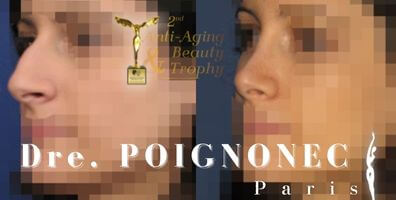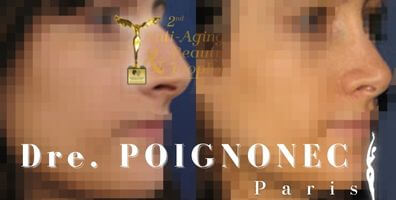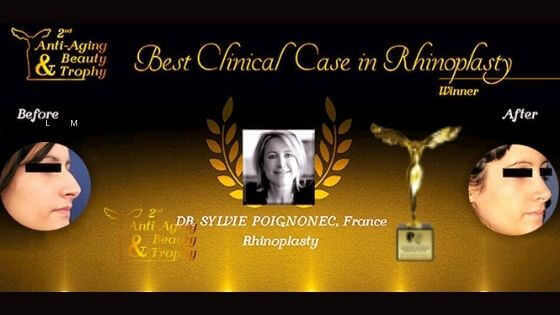Piezotome® ultrasound engine for minimally invasive rhinoplasty simpler aftercare less bruising
Rhinoplasty for nose complex
Doctor POIGNONEC aesthetic surgeon at the medical aesthetic practice Paris - Eiffel
Ultrasonic rhinoplasty
A revolutionary technique in aesthetic surgery
Ultrasonic rhinoplasty, also known as piezo rhinoplasty, has emerged as an innovative development in cosmetic nose surgery. Unlike traditional methods, this technique uses ultrasound instruments to reshape bone and cartilage structures with greater precision. This article takes an in-depth look at this innovative procedure, its advantages and disadvantages, and how it differs from conventional techniques.


Understanding ultrasonic rhinoplasty
Origin and development of the method
Ultrasonic rhinoplasty was born out of the need to reduce complications and improve post-operative results compared with conventional techniques. The first clinical trials showed that the use of ultrasound gave unprecedented control over surgical procedures. Since then, it has established itself as a credible alternative to traditional methods using hammer and chisel.
The technology behind the procedure
The heart of this technique is a piezoelectric device that converts electrical energy into ultrasonic vibrations. These vibrations are then used to cut bone and cartilage tissue precisely and selectively. Compared with conventional mechanical tools, ultrasonic technology enables osteotomies (bone cuts) to be performed more cleanly and less invasively.
Stages of the operation
Initial consultation
The first stage of an ultrasonic rhinoplasty involves a thorough consultation with the surgeon. This includes a detailed morphological assessment, as well as a discussion of expectations and potential achievements. Pre-operative images can be taken to help plan the procedure.
Pre-operative planning
During this phase, the surgeon designs a precise surgical plan, often using 3D modelling software. This planning not only helps to visualise the expected results, but also to anticipate and minimise potential risks.
Precise surgical procedures
Once in the operating theatre, the use of ultrasonic instruments enables the surgeon to perform highly precise procedures. The use of these tools minimises trauma to adjacent tissues, reducing bruising, swelling and recovery time.
Comparison with traditional rhinoplasty
Advantages of the ultrasonic method
- Greater precision : Ultrasonic instruments enable bone structures to be cut cleanly, thereby limiting tissue trauma.
- Less post-operative pain: The reduction in trauma leads to a significant reduction in post-operative pain.
- Rapid recovery : Patients often experience a shorter recovery period compared with traditional techniques.
- Reduced bruising and swelling : The minimally invasive approach reduces common side effects such as bruising and swelling.
- Predictable results : Thanks to the precision of the gestures, the results obtained are generally in line with the expectations initially set.
Disadvantages and limitations
- High cost : Due to the sophistication of the technology, this method can be more expensive than traditional rhinoplasty.
- Limited availability : Not all surgeons have the necessary training or access to ultrasonic instruments.
- Operating time : Operations can sometimes take longer because of the meticulousness required with ultrasonic instruments.
Practical details of ultrasonic rhinoplasty
Preparing for surgery
As with any surgical procedure, adequate preparation is essential to maximise the chances of success. This includes thorough medical examinations, stopping certain drugs that can interfere with blood coagulation, and a series of dietary recommendations to be followed before the operation.
Recourse to anaesthesia
Ultrasonic rhinoplasty is performed under general anaesthetic or local anaesthetic with sedation. The choice of anaesthetic depends mainly on the patient and the extent of the operation to be performed.
Post-operation and medical follow-up
After the operation, the patient is monitored for a few hours before being able to go home. Post-operative monitoring includes regular visits to the surgeon to ensure that the wound is healing properly and to remove any stitches if necessary. Intense physical activity is not recommended during the first few weeks in order to promote healing.
Future prospects for ultrasonic rhinoplasty
Technological improvements
Constant advances in ultrasound technology promise even more precise and effective instruments. These improvements could make the technique accessible to a greater number of patients, while continuing to reduce the associated risks.
Expanding our surgical offering
With the growing success of ultrasonic rhinoplasty, more clinics and healthcare professionals are considering training in this method. This could democratise access and enable more people to benefit from the considerable advantages it offers.
Overall impact on cosmetic surgery
The widespread adoption of ultrasonic rhinoplasty could mark a profound transformation in cosmetic surgery. By making procedures safer and results more predictable, it is setting a new quality standard in the treatment of both functional and aesthetic nasal deformities.


